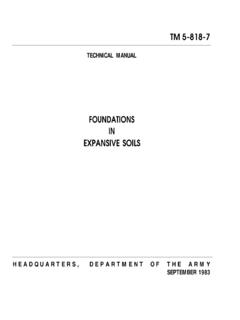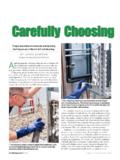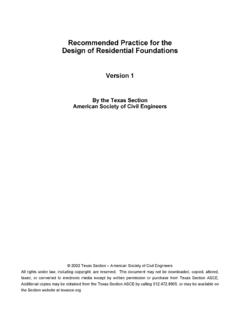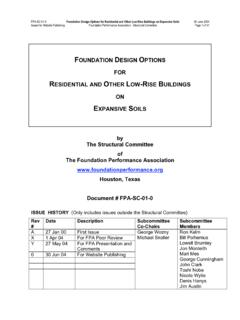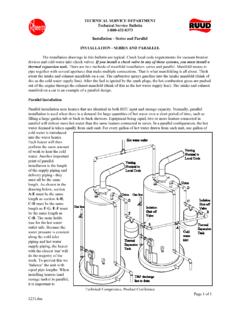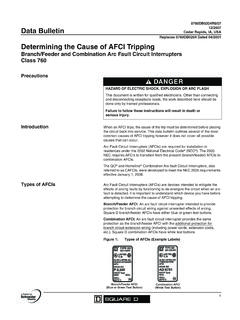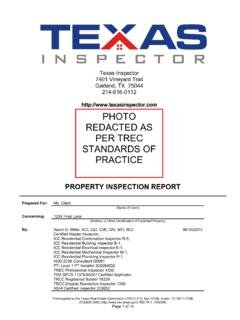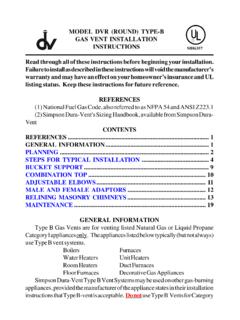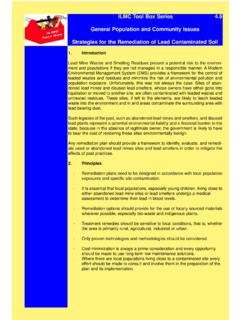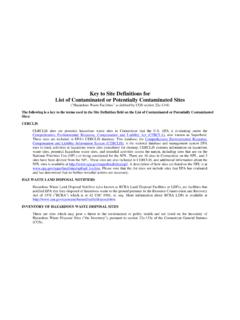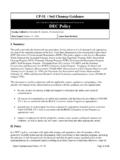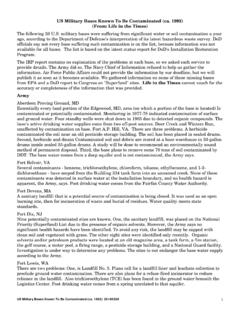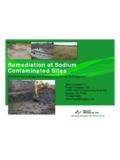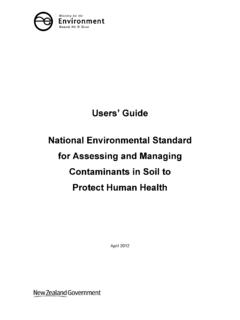Transcription of Soil Issues for Residential Construction in Texas
1 2009, Homeowners of Texas , Inc. January 2009 Homeowners of Texas , Inc. ( ) is a non-profit corporation, formed in May 2008 to enhance the homebuilding industry and restore consumer trust. Our aim is to ensure that new Construction and remodeling is properly engineered and then built with licensed skills and regulatory oversight to protect homeowners from the devastating effects of substandard Construction . soil Issues for Residential Construction in Texas We offer this document to alert builders, homeowners and policy makers of two concerns that worry us about homes built on reclaimed farm and ranchland. The first concern relates to expansive soils that are unsuitable for building and that cause foundation problems and threaten the structural integrity of homes. The second is residual contamination from industrial waste or toxic pesticides that can cause serious health problems.
2 These two Issues , discussed below, are especially troublesome because of the rapid rate of urban sprawl in our state. To address these soil concerns without stifling economic development, our Texas Legislature proposals include soil testing and foundation engineering. Our national agenda includes repeal of the Brownfields Law ( Small Business Liability Relief and Brownfields Revitalization Act). Urbanization Urban sprawl is a national trend where cities expand geographically into the adjacent countryside at greater growth rates than their population increases. The amount of land used for urban space increased by 47% from 1982 to 1997 while the population grew just 17%. With million acres of fertile soil , Texas has more prime farmland than any other state, according to the Department of Agriculture. At least million acres of that farm and ranchland were converted to neighborhood developments between 1982 and 1997.
3 Most affected was the Texas Blackland Prairie, which got its name from the fertile soils that are rich in black clay and noted for helping Texas become the nation s top cotton growing state. Source: Agriculture and Urban Sprawl, Urban development of farmland, combined with access to immigrant workers, has contributed to relatively low building costs in Texas ; but the lack of regulatory oversight and accountability has attracted some irresponsible builders to our state. Foundation Problems caused by Expansive Soils Few consumers know about the structural integrity risks of buying homes built on shifting or expansive soils. Especially troublesome are new homes built in the Blackland Prairie, a belt of fertile black clay that is bounded on the west by the Cross Timbers and Prairies Region and in the east by the Post Oak Savannah Region, extending southwesterly along Interstate-35 from the Red River to San Antonio about 12 million acres in all.
4 The region gets its name from the rich, black, waxy, alkaline and calciferous soil that retains water and yields highly productive farmland. The City of Hutto, which is in the middle of the Blackland Prairie and was known for ranching and cotton farming before its recent urbanization, has recently become one of the fastest growing small cities in America, enjoying a growth rate of soil Issues for Residential Construction in Texas 2009, Homeowners of Texas , Inc. January 2009 about 880% between 2000 and 2005 (per Wikipedia). But it seems that Hutto land is better suited for growing crops than building homes. The Department of Agriculture Natural Resources Conservation Service has determined that most of the land in Hutto is made up of the most expansive type of clay. According to the department, the soil is very limited for building, with weaknesses that generally cannot be overcome without major soil reclamation, special design, or expensive installation procedures.
5 This explains why so many homes in the communities of Hutto Parke and Legends of Hutto have had serious foundation problems. Widespread problems in homes built by a few volume builders who didn t take proper engineering precautions have caused these neighborhoods to rapidly decline. Blackland clay has been called "nooner" soil because it s often too gummy to plow on wet mornings but can dry as hard as concrete by mid-afternoon. Even today, a brief shower can make unpaved farm roads dangerously slick or impassible, even for four-wheel drive vehicles. The reason black clay causes foundation problems is the fact that it expands greatly when wet and contracts when dry. Structures at Risk Expansive clay soil , also called shrink-swell soil , causes billions of dollars of damage in the United States each year. With the ability to expand in volume up to 30% or more when water is absorbed, expansive soils can generate tremendous pressure on structures such as concrete foundations.
6 These pressures, which have been measured as high as 15,000 pounds per square foot, can cause foundations to heave when wet and sink when dry. Either way, damage can be extensive. According to Foundations in Expansive Soils, a document by the Department of Defense, the types of structures most often damaged by swelling soil include foundations and walls of Residential buildings. Lightly loaded one- or two-story buildings, warehouses, residences, and pavements are especially vulnerable to damage because these structures are less able to suppress the differential heave of the swelling foundation soil than heavy, multistory structures. 2009, Homeowners of Texas , Inc. January 2009 Government and commercial buildings in Texas are required to be engineered by professional engineers and built by licensed and bonded contractors, but Residential Construction is exempted from these rules.
7 That s both foolish and irresponsible. The three most common foundation designs for expansive clay are: 1. Conventional slabs-on-grade; 2. Postensioned slab-on-grade; and 3. Pier and beam. To ensure the long term structural integrity of Texas homes, these foundations must be designed to handle two conditions: (1) center lift (also called center heave or doming) and (2) edge lift (also called edge heave or dishing). Type of Damages Structural damage can result when if foundations are not designed for specific soil and environmental conditions. These damages include distortion and cracking of pavements and on-grade slabs, cracks in walls & beams, and jammed or misaligned doors & windows, among others. Doming heave is a foundation distortion that can occur over a period of years due to progressive and upward swelling beneath the center of the slab.
8 The corresponding dome-shaped heave causes external walls to lean outward, resulting in horizontal, vertical, and diagonal wall fractures, with cracks generally wider at the top. Additional horizontal fractures can appear at the top of the wall near the roofline. Edge heave is a dish-shaped distortion that may be observed relatively soon after Construction , especially if dry surface soil is suddenly exposed to water during a rainy spell or with irrigation. Localized heaving may occur near water leaks or areas of standing water. Expansive soil MovementCenter Lift of a House FoundationConventional slab-on-grade designs feature deepened perimeter footings that extend below the primary zone of cyclic heave and shrinkage. Concrete for the footings and interior slab is usually poured at the same time over plumbing and rebar for added strength.
9 Posttensioned slab-on-grade designs replace rebar with steel cables that are greased and run through plastic sleeves and later tensioned with hydraulics to create rubber band like forces pulling inward on the foundation. Still, fractures can occur unless structural engineers design for specific soil conditions. 2009, Homeowners of Texas , Inc. January 2009 Cyclic heave relates to the expansion and contraction over time, based on changes in weather, the frequency and amount of rainfall, and even automatic sprinkler cylces. Lateral movement can cause basement and retaining walls to bulge and fracture. Assessing Risk Foundations must be properly engineered for different soil and environmental conditions or serious failures can occur. But soil conditions vary widely across the state, and over 100 soil types are found in Travis County alone.
10 That s why each Construction site should be tested by a geotechnical engineer to determine the plasticity index of representative soil samples. Plasticity index is a measure of how expansive the soil is and how its characteristics change with moisture. Other factors used in assessing environmental risks include: water-table depth, climate, topology, drainage, surface irrigation, landscaping & vegetation, condensation from water lines & sewers, heat sources that cause drying, and thermo-osmosis a process where moisture migrates from a warm zone outside of the home to a cooler zone underneath. Understanding these various factors can help structural engineers design sound foundations. Preventing Failures We ve all heard the myth that homeowners can prevent foundation failures by watering the lawn properly and not allowing standing water to pool at the foundation.
